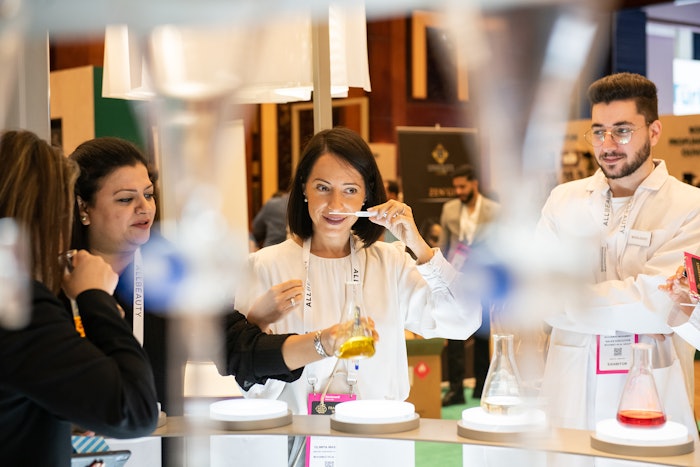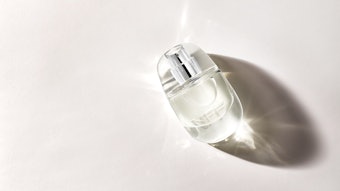
The Middle East fragrances market size reached a value of approximately $3.76 billion in 2023, according to Expert Market Research. The market is expected to grow at a CAGR of 7.50% between 2024 and 2032, reaching a value of around $7.21 billion by 2032. To shine a light on this incredible growth, BeautyWorld Middle East returns October 28-30 at the Dubai World Trade Centre. The trade show is set to host 2,000+ exhibitors and 7,000+ attendees representing over 150 countries.
Perfumer & Flavorist+ connected with market experts from CPL Aromas and Mane to share what you need to know in preparation for the return of BeautyWorld 2024 in Dubai this October.
 BeautyWorld attracts key players from the global fragrance industry, including mass market, niche brands, and raw material suppliers.courtesy of BeautyWorld
BeautyWorld attracts key players from the global fragrance industry, including mass market, niche brands, and raw material suppliers.courtesy of BeautyWorld
Are there any innovative fragrance formats that are gaining popularity in the region?
Rawya Catto, General Manager at CPL Aromas, Middle East [RC]: There is an interesting phenomenon in the Middle Eastern market that is driving the adoption of new and innovative formats. The way consumers use fragrance is very diverse. They fragrance their clothes, their hair, their skin… and use different ways to create their bespoke signature scents. This is driving the design and adoption of innovative packaging ideas, and even fragrance formulations.
In terms of packaging, Kuwaiti and Saudi brands led the way on the macro bottles, the 200ml formats. Local UAE brands are driving limitless innovation in bottle design, texture, craftsmanship and colors. The use of Arabic calligraphy is also a stunning cultural nod, more and more utilized in regional design codes.
We are also seeing innovation in a category that needs it: Bakhoors! Packaging and olfactive are modernizing. I particularly like the Bakhoor hair combs and the graphic architectural Bakhoor burners that brands are coming up with. Hair mist remains a staple, and new scented hybrid fragrances and skin care formats are appearing.
I still see room for ideas and innovation, especially as the demand for perfumed products continues to increase, and the desire for convenience and diversification is driven by the consumer’s taste.
 Ingredients like saffron, musk, and dates are ever-growing in popularity, and consumers are seeking the opulent richness of Middle Eastern cultural notes in modern and innovative ways.courtesy of Beautyworld
Ingredients like saffron, musk, and dates are ever-growing in popularity, and consumers are seeking the opulent richness of Middle Eastern cultural notes in modern and innovative ways.courtesy of Beautyworld
What are the biggest challenges facing the fragrance market in the Middle East?
RC: Across the board, the Middle Eastern landscape is challenged by unprecedented instability on the geo-political front. This is putting pressure on the industry when it comes to supply chains, components, and the reliability of the logistical routes. We have to plan earlier, and better.
We are also seeing an accelerating challenge facing the whole fragrance industry now, due to climate change. Some of our beloved ingredients are coming under strain, with crops and yields being directly affected by too much or too little rain.
Awareness and mindfulness need to come into play for us as a fragrance house when designing the scents of tomorrow. For example, we chose not to include Palo Santo oil directly into our palette, because of how unsustainable the harvest of the crop is. Instead, we utilized technology to create an Aromaspace alternative that allows our perfumers creativity without harming our shared resources!
We have a shared responsibility to continue to deliver beautiful perfumes that delight consumers, all the while thinking about tomorrow’s generation.
Maysoon Younis, General Manager at Mane: The fragrance market in the Middle East is undergoing significant changes, with increasing fragmentation as tens of new brands are launched every month. This shift is driven by evolving consumer lifestyles and expectations, marking the beginning of a new era where fragrance is becoming more integrated into the broader beauty domain, much like the Western model. Traditionally, fragrance in the Middle East has been a standalone category, but now, aspirational marketing and storytelling are reshaping the industry. Influencer marketing is on the rise, as consumers are increasingly engaging with brands online on a daily basis, driving deeper connections. At the same time, competition is intensifying, especially from independent niche brands that have made the Middle Eastern market a key focus. These brands have gained wider access to consumers through the expansion of specialized niche retail, challenging traditional players and changing the competitive landscape.

Can you provide an overview of the current state of the fragrance market in the Middle East?
RC: This is an exciting time for the Middle Eastern fragrance market. The world is in love with perfume, and the more intensity, punch, and character, the better.
Regional brands are finally getting the global recognition they deserve, and rather than following trends, they are now setting them. Consumers and influencers, globally, are resonating with these brands, thanks to the information flow through socials.
Be it in terms of packaging, fragrance design, dosage and intensity, Middle Eastern brands are innovating in ways never seen before.
The UAE remains a regional perfumery hub, a platform to design, create and export all over the world.
Saudi Arabia is challenging the status quo, with brands piloting new distribution models, heavily reliant on digital.
Kuwaiti brands bring sophistication and innovation, with disruptive formats, and interesting cross-brand fertilization and collaborations.
Next door in Oman, Amouage is leading the way globally on how the future of perfumery should look, at all levels of the supply chain, with best-in-class technology and innovation leading to unprecedented global success.
Speed, agility and creativity are key to asserting competitiveness in the market.
 The world is in love with perfume, and the more intensity, punch, and character, the better.courtesy of Beautyworld
The world is in love with perfume, and the more intensity, punch, and character, the better.courtesy of Beautyworld
How does Middle Eastern culture influence fragrance preferences and consumption habits?
RC: We have been talking about the cultural influence of the Middle East for a little while now. I see it as something that has become part of the scenting rituals of consumers, not just in the Middle East, but globally, through the connected youth.
In this part of the world, fragrance is one of the definers of someone’s personality, social status, and uniqueness. Middle Eastern woman and men create their own blends by layering different perfumes and formats and adapting them to seasons and occasions.
People are now sharing these tips and secrets online, and it opens up a whole world of fun! TikTok and Instagram present wonderful platforms to share new combinations, blending for example the latest launch from a niche Italian brand with a bargain market find from a UAE brand, to create a fragrance that lasts and lasts and lasts.
I was at a niche perfumery trade show last year in Europe and was astonished at the number of Middle Eastern brands represented there. The influence of the culture is no longer only in the way fragrances are used, but also starting to deeply seep into olfactory preferences. Everyone wants to “smell like an Arabian prince!
We’ve seen a lot of influence on the Western market from the Middle East –from layering scents to the utilization of oud – can you share some insight into that influence?
Ravi Ramchandani, show manager at Messe Frankfurt [RR]: The influence of the Middle East on the Western fragrance market has been profound in recent years. From the global adoption of oud, (with different levels of intensity and authenticity) to the shift of consumer preference toward rich and opulent scent, Middle Eastern perfumery has moved from niche to mainstream.
Consumers all over the world are familiar with the key accords of Arabian perfumery. The generalized presence of intense dry ambers in many scents, seeking lasting and sillage, is also to be a by-product of this influence.
Ingredients like saffron, musk, and dates are ever-growing in popularity, and consumers are seeking the opulent richness of Middle Eastern cultural notes in modern and innovative ways.
More interestingly, and at a wider scale, having more diverse voices in the perfumery world is leading to more creativity and novel creations at the ingredient level. From local Saudi Arabian ingredients like “Habag Mint” to food-related influences, like Egyptian Guava or Alphonso Mango, perfumers are looking into culture at a deeper level to create scents that not just resonate, but bring novelty to the table.
The influence is also now two ways.
We are also seeking to bring typically Western accords, or even explore ingredients from other parts of the world, and play with contrast them with Middle Eastern staples…the sky is the limit when we seek true scented stories, respectfully influenced by regional cultures.
 The Next in Beauty conference will feature discussions on the Middle Eastern, Chinese, and Indian fragrance markets.courtesy of Beautyworld
The Next in Beauty conference will feature discussions on the Middle Eastern, Chinese, and Indian fragrance markets.courtesy of Beautyworld
What can attendees expect to experience while attending Beauty World 2024?
RR: Beautyworld Middle East’s Fragrance section is one of the most prominent areas of the event, showcasing a wide range of perfumes, essential oils, and fragrance-related products covering 14,000 sqm and featuring over 200 exhibitors. It attracts key players from the global fragrance industry, including mass market, niche brands, and raw material suppliers.
Recognizing the region's importance when it comes to fragrance, IFRA will host its “Global Fragrance Summit” during BWME, and our Next in Beauty conference will feature discussions on the Middle Eastern, Chinese, and Indian fragrance markets. Exciting features include the return of Signature Scent powered by Air Parfum, where top fragrance houses will create their interpretation of a signature scent. The 5th edition of the BWME awards will also take place, with categories like Niche Fragrance of the Year and Popular Fragrance of the Year receiving over 100 nominations.
It’s a premier platform for establishing valuable business connections, exploring partnerships, and building relationships with distributors, retailers, and key decision-makers in the fragrance industry.










